
|   |

|   |
 e-mail: sunilkothari1933@gmail.com Nrutya Rangoli dance festival and seminar Photos courtesy: Academy of Music & Veena Murthy Vijay April 24, 2018 Academy of Music, Bangalore, under its aegis invited Veena Murthy Vijay to curate and conduct the annual dance festival for three days along with two morning sessions for dance seminar at Chowdaiah Memorial Hall (April 13, 14 and 15). Titled as Nrutya Rangoli, Veena Murthy planned an inclusive dance festival which was from the word go a success. On the opening evening, Veena Murthy Vijay's institution Sri Raja Rajeshwari Kalaniketan presented group choreography of deepa dance in Kuchipudi. From young tiny tots, holding lamps in their hands to the senior dancers, balancing on their heads brass pots filled with water and in two hands holding lamps, performing simple movements and forming various groupings, it looked quite spectacular. The background instrumental music before the dance began was of Thyagaraja's Endaro mahanubhavulu spreading the auspicious mood. Veena Murthy had introduced various sculpturesque poses to give an overall view for the group dance, a variety. In front were kept four inverted pots. Slowly dancing to the recorded music, the senior dancers moved forward and from two sides, tiny tots arrived in one line. They created quite an impressive sight. When the senior dancers climbed over the pots and balanced themselves along with brass pots on their heads and lamps in their hands lifting one leg and forming visual design, the audience gave them spontaneous ovation. After the group dance, Divya Hoskere, a disciple of P Praveen Kumar, presented in Bharatanatyam, a prayer in praise of Lord Shiva. Both in nritta and abhinaya, Divya showed her competence. From Mysore were invited students of Bharatanatyam department of K S Gangubai Hangal Music and Performing Arts University. The dancers began with Pushpanjali. In their other presentation in Sri Ranjani raga, two dancers elaborated upon phrases like pankajalochani, nayika with eyes like lotus, manjubhashini, whose speech is pleasant, manollasini, playing veena and enjoying. In between were sung solfa, swaras, to which nritta was woven. The raga employed was Megharanjani and the dancers reverted to the phrase Pankajalochani.
But the evening belonged to Sheela Unnikrishnan and her dancers of Sridevi Nrityalaya from Chennai. I had not seen her choreographic work so far, except that I had met her during Natya Kala Conference, but had missed her full work on Leela Taranga Margam which she had presented at The Music Academy's Dance Festival. She presented excerpts from that complete work as the time allotted was 45 minutes. For the choreographic works, in five selected tarangam verses, her uniformly trained dancers, danced with precision and perfection, creating visual poetry to the Sanskrit text of Krishnaleela Tarangini. The description of ten incarnations of Lord Vishnu, each one in succession with neat hastas, in kavutvam like formation, was quite enchanting. The seven dancers formed a symmetrical crescent and their swift movements were captivating. The epithets like Taralita kundalam Shri Krishna, Tandavalola Shri Krishna, turned into beautiful images. The section in Hamsadhwani and rupaka tala to the singing of Jaya Gokulabala with three dancers was equally enjoyable. The light footed movements were pleasing. They formed shrinkhala, chain formation praising Sri Krishna as Yadukulabhushanam, one who is an adornment of Yadu clan and whose greatness is praised in philosophy of Vedanta and Agamas. The duet of Radha and Krishna was most enchanting. The erotic sentiment found felicitous expression in their intimacy. Their sitting on a swing, being in a nauka, boat and similar images were choreographed with imagination. The sequence of marriage of Rukmini, the use of nagaswaravali and tillana like tarangam were performed with such vibrancy and uniformity that it brought down the house. The covering of the stage like periya adavu was well performed. Their exit like gazelles was sparkling. The overall impression Sheela's dancers created, was like that of a ballet company seen in the west, in terms of excellent nritta. In abhinaya, as one notices in a kavya, a poem. Suggestions played important role. Therefore the excerpts of Leela Taranga Margam appeared even more pleasing. Later on, on inquiring about Sheela's background, I came to learn that she had also studied Kuchipudi under Vempati Chinna Satyam. But her training in Bharatanatyam was under Mangudi Dorairaj Iyer. Sheela prefers to choreograph in Bharatanatyam style only and has achieved considerable reputation. I suggested to her that she need not ask her dancers holding a mike to announce the gist of the tarangam in English, as it breaks the illusion already created of gopis dancing. The announcements should be made off stage by someone else. The next evening performances included presentation of duet in Kuchipudi by Veena Murthy's disciples Chethan Gangatkar and his wife Chandraprabha Chethan. Chethan's Sandhya Tandava was replete with lilt and power of Kuchipudi. Set to Ragamalika and adi tala, it included in its choreography the Devas playing various instruments - Vishnu playing mridangam, Brahma and other gods various other instruments. The suggestion of creation, preservation and destruction was conveyed suggestively. Bhujangachita, Garudapluta, Suchipada and other karanas were performed with ease. Chethan has to guard against over dramatization. Their duet had lot of hasya rasa in a javali. The nayaka had promised golden ornaments to the nayika. But he does not bring them and has evidently forgotten. Therefore to make up for his forgetfulness, he flatters her by comparing her face to moon, the smile to a beautiful fruit and so on and wins her over saying that the golden ornaments do not matter, as she is supreme to him. Both performed it with aplomb and brought a touch of humour. 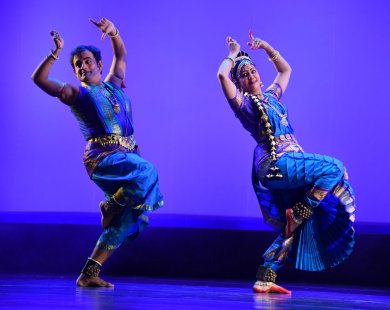 Chethan Gangatkar and Chandraprabha 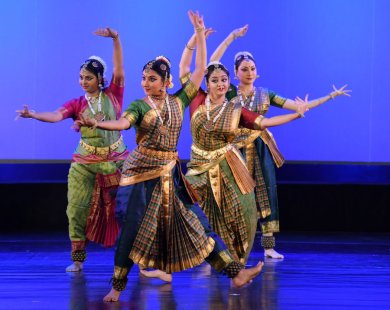 Nritya Karnataka Lalitha Srinivasan's group presentation Nritya Karnataka was in keeping with the high standards of training at her institution Nupura. The text was composed in Sanskrit by Lalitha. Set to Ragamalika in praise of Shri Krishna with several epithets like Rukmini Vallabha, Sumanohara Murari, Vasudeva Devaki Nanda Govinda, Mukulananda, and so on interweaving the story of how after Krishna was born, Vasudeva took him to Gokul and placed him at Yashoda's place and brought Maya to jail. The four dancers including Ajay, performed in different combinations and formations keeping the flow of the text with suggestive episodes of lifting mount Govardhana, subjugating Kaliya serpent and so on. Playing Rasalila they moved in a circle, clapping as in a tala rasaka. As Paramapurusha, Parthasarathi, driving the chariot of Arjuna in battle, in Gitopadesham saying to Arjuna to leave all others and take refuge unto him, sarva dharman paritajya mameka sharanam vraja, the choreography concluded on a note of joy. Ajay, Mansa Rao and other two dancers performed with élan and sophistication. 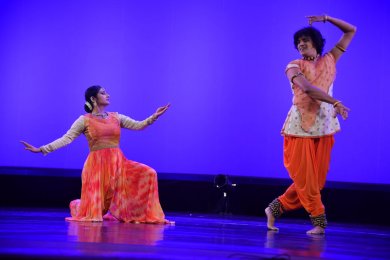 Nirupama and Rajendra
The last presentation was by Kathak duo Nirupama and Rajendra. Their new
choreographic work Abhisaar was earlier presented in UK, but was not
seen in Bangalore. It explored the imaginative music composition with
Kathak movements. Retaining all the elements of Kathak, with footwork,
chakkars, and graceful movements as devised for male and female,
suggesting two lovers, the duet dance moved with lyricism. Add to it,
appropriate lighting and colourful specially designed costumes, the
impact was visually stunning. The seasons of varsha, shishira, vasanta
were interpreted suitably along with the melodious music. The suggestive
abhinaya, the river banks, the rituals of worship, the flow of river
were danced gracefully. In a solo for Abhisaar, on way to meet beloved,
Nirupama, as abhisarika nayika moves boldly through forest not worried
by the obstacles she would encounter, saying that Lord Manmatha was
following her, so why should she be worried?.In Kathak dancers interact with audience. Nirupama asked members of the audience if anyone wants to suggest a different end. Few suggestions were made but one was interesting. Instead of meeting the beloved nayaka, if she were to meet someone different than her lover. Nirupama took up the challenge and had audience in splits when the nayaka who she was expecting to meet was someone else, quite frightening in looks, and she runs away! The finale was in praise of Lord Shiva, he playing damaru and dancing. Rajendra energetically displayed the various ways the drum was played, and Nirupama as Parvati used some of the karanas striking various sculpturesque poses dancing around Shiva. Their duet was impressive. The various karana movements were suggestive as performed in Bharatanritya terminology of Dr. Padma Subrahmanyam. Nirupama and Rajendra have a loyal following of fans who follow them wherever they perform. On this evening also there were a large number of their admirers. But most important were the two celebrated musicians, flautist Praveen Godkhindi and music composer Praveen D Rao. Their collaboration enriches their dance. In terms of aharya, the designed costumes have a strong visual appeal. Though at times because of the exposure to the costumes one notices used in Bollywood films, one starts feeling uneasy seeing the costumes which though are discreet, give an impression of the ones used aggressively in films. While designing the costumes for Kathak, Nirupama and Rajendra are careful and cautious. However, they would do well to tone down this influence. Their dancing is solid and minus any other elements they stand on their own, with sound training and exposition. Reacting to my own uneasiness at the opulence of colours of costumes, I feel they will have to find a way to bring the element of sobriety without losing the joi de vivre of dance. On final day, the festival offered sumptuous fare of Kuchipudi. Earlier in the morning session, young M Ananya , a disciple of K Brunda and Shankar Kandasamy, in dancing Sankaracharya's Ardhanarishwara, brought vivid imagination to her rendering both the aspects of Purusha and Prakriti and how both when united create totality. Her dance was flawless for one so young. Often dancers stand with their back to the audience and then turn to face the audience. They want perhaps to create curiosity in audience, but it seems unnecessary. If a dancer stands in pose of Ardhanarishwara, even from frontal view, it would be equally impressive.
The choice and select repertoire of Veena Murthy's Samanvay Dance Company in quick tempo, performing Ramayana sabdam, which dwelt upon the key incidents of Ramayana was quite impressive. From putrakameshti, the birth of four children of Dasharatha, their growing up, Rama and Lakshmana going to forest, to Sita being enticed by golden deer Maricha, Lakshmana drawing three lines that Sita crosses, Ravana kidnapping her, were all enacted in quick succession with quicksilver movements and abhinaya. It is in its presentation that Kuchipudi succeeds in Sabdams. This is a special genre of Sabdams in Kuchipudi. I enjoyed revisiting the Ramayana Sabdam. All the dancers performed with complete involvement. Tarangam by more than six dancers dancing on brim of brass plates had, as expected, instant response. When dancers get off the plates, Veena Murthy's choreography made them throw up the plates in the air and then catch them in a trice with perfect synchronization. The renowned Kuchipudi artist, guru and choreographer KV Satyanarayana, a disciple of Korada Narasimha Rao, was honoured with Samanvay Puraskar and a golden bangle, Simha kankanam. KV Satyanarayana handles mythological stories with great dexterity, which keeps audiences glued to their seats, be it in India or abroad. He presented from his Kavyanayakalu, written by Dr. Radhavallabh Kavitha Prasad, two episodes - one of Parijata Apaharana of Nandi Timmana and other from Amukthamalyada of Sri Krishnadeva Raya, dwelling upon marriage of Godha Devi with Lord Ranganatha. The music was composed by K. Suryanarayana and DSV Sastry. The singers were Sasikala, Nitya Santhosini, Ramakrishna and DSV Sastry. The sakhis tell Satyabhama that Sri Krishna has given Parijata flower to Rukmini, and she need not pride herself as the most favorite of Lord Krishna. Satyabhama is influenced by sakhis and when Krishna visits her palace, she sulks and does not respond to Krishna's trying to find out why was she was annoyed with him. The entire episode and attempts by Krishna to please Satyabhama were delicately handled by Srinivas and role of sulking Satyabhama by P. Anjali. Sri Krishna on knowing the reason of Satyabhama's sulking, promises her to bring the entire Parijata tree, leave alone giving her one Parijata flower. The reconciliation was enacted by both dancers in a dignified manner. Similarly in Godha Kalyanam, Godha's role played by Lohitha and that of Lord Ranganatha by Srinivas was noteworthy for their ability to become one with the character. Godha prepares the garland for Lord Ranganatha and before it is sent to the temple, places it on herself and admires it; those sequences were depicted with graceful Kuchipudi movements bringing out the character of devotee Godha, anxious to marry Sri Ranganatha. Vishnuchitta, father of Godha, played by P.Kedhar, is pleased to learn that Siva, Parvati, Brahma and Saraswati, on behalf of Sri Ranganatha, have arrived to meet him to give consent of Sri Ranganatha's acceptance of Godha Devi's marriage. The lyrics, with melodious music and joyous dancing by Godha and her sakhis were performed with spirit of happiness. The seven steps Sri Ranganatha takes with Godha Devi, the rituals of marriage and their union bring to end the dance drama on an auspicious note. 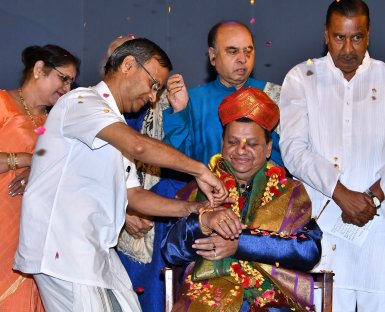 Samanvay Puraskar to KV Satyanarayana 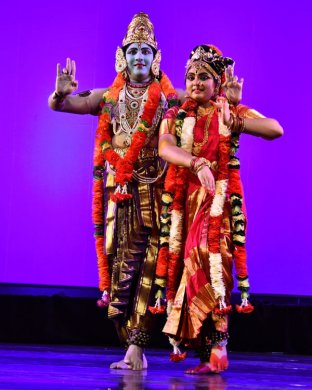 Kavyanayakalu These two episodes full of devotion bring out the beauty of Kuchipudi in traditional manner. K V Satyanarayana is known for his choreography and handling of the theme in an effortless manner. His dance dramas are very popular. I enjoyed his presentation as they were free from any attempt to impress, and were performed with ease. They evoked the old world charm of Kuchipudi, as did choreographic works of Veena Murthy. Having seen works of legendary Vempati Chinna Satyam in Kuchipudi, while getting an opportunity to see other aspects of traditional exposition, one felt how enriching is the tradition. One watches these dance dramas choreographed without any burden of pleasing the city audiences. The two day seminar I would like to compliment curator of the festival Dr. Veena Murthy Vijay for planning serious discussion and demonstration on Banis of Bharatanatyam by local dancers in the morning session on April 14th. Prof Mysore V. Subramanya was chairing the session and participants were Lalitha Srinivasan for Mysore bani, Padmini Ravi for Vazhuvur bani, Poornima Gururaja for Tanjavur bani and Kiran Subramanyam and his wife Sandhya for Kalakshetra bani. Some thirty students and dancers had registered for Creative Lab –interactive session in nature of very brief workshop. 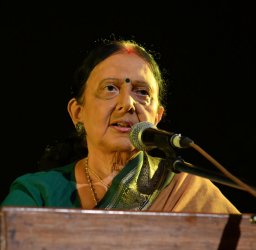 Lalitha Srinivasan 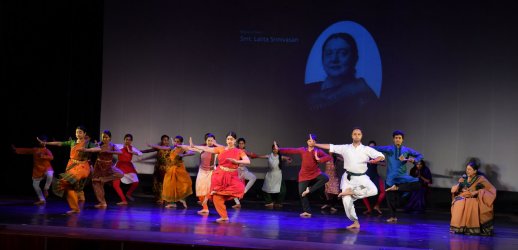 Lalitha Srinivasan's group Lalitha Srinivasan is a disciple of Mysore palace dancer, asthana vidushi and legendary exponent of abhinaya, Guru Venkatalakshamma. She has also studied under Keshavamurthy and Mugur Jejamma. She gave a brief history of how Mysore bani had come to stay. Another legendary dancer like Jatti Tayamma's contribution was also remembered. She also mentioned about salient features of Mugur style. The repertoire consisted of Suladi, Varnams, Jakkini daru, tillana. She observed that the rendering of Amarushataka before a padam or javali was a sheer delight to watch; it was so devised for understanding of the mood of the nayika. Noteworthy were the graceful body movements. Lalitha asked her students to demonstrate the typical adavus of Mysore bani, cross leg movement, raising one leg across other on knee level and with typical hastas. The old order of a dancer enacting abhinaya in both directions was adhered to. Lalitha spoke of subtleties, and not over dramatizing of the abhinaya. She said that a dancer need not trespass the area of natya, theatre and need not enact sancharis elaborately. It should be suggestive. Her disciples demonstrated the adavus which registered students while taking part in workshop danced to get the feel of it. Young established dancers like Mithun Shyam and Yogesh and young female dancers had a go at the movements. Very erudite and thoughtful explanation by Lalitha was enlightening. Padmini Ravi, a disciple of KJ Sarasa with an approach of down memory lane, spoke of her early struggle of settling down in Bangalore from Chennai after her marriage and taking to dance in Bangalore. She admitted that from KJ Sarasa she never learned the hastas or theory. That she learned much later. She said that she had no clue of Abhinaya Darpana and viniyogas of the hastas or charis, or sthankas etc. She mentioned that when very young she used to dance the serpent dance like Kamala, and was known as 'Pambu Padmini' as she could dance with all serpentine movements. Sarasa was a bold teacher. Ramaiah Pillai had told Sarasa that she was not a beautiful woman with great figure or face and if she wanted to serve dance, she could as a teacher pass on her knowledge. Sarasa accepted and did gurukulavasa, staying at Guru's residence, washing vessels, sweeping the floor. She responded to music and moved the way she liked including hip movements, which normally would be considered taboo. Sarasa would tell her disciples to move raising their hips. She was bold and made her disciples also learn to be bold. Sarasa would give direction for dance in films also. Thus Padmini had come in contact with many film directors, dance choreographers and musicians. She felt that she should respond to music and by the time she had listening to the music visualized the choreography; she would dance to that choreography, never minding hip movements. While directing dance in film Shringara, they had invited Saroj Khan who would tell her dancers 'upar karo', meaning move your hips up, up. Padmini played some music on cell phone and asked the young dancers to follow her while performing Ganapati stuti and movements for Ganapati's trunk, raising an arm, bringing knees close, keeping feet apart and turning sideways and danced. Padmini mentioned that she was not a scholar or an academician. She moved in response to music and did not bother if scholars or academicians liked it or not. She told young students to be bold. She mentioned that later on when she learned from Swamimalai Rajaratnam Pillai who was a musician too, he allowed dancers freedom. We see that Malavika Sarukkai, Urmila Satyanarayanan, and Priyadarsini Govind who learned from Rajaratnam, perform individually. Sarasa took what she liked from other styles also. She would ask her cousin Dandayuthapani Pillai to show her some movements and would incorporate them in her dance. It was interesting to learn a lot about Sarasa from Padmini who had studied under her from a very young age. Padmini said that she did not know much about bani but preferred to be free from burden of bani. Padmini Ravi seemed to be in a lighter mood and one was surprised why she chose to speak in this vein. She is a very gifted dancer and I have memories of seeing her excellent performances and of her disciples. 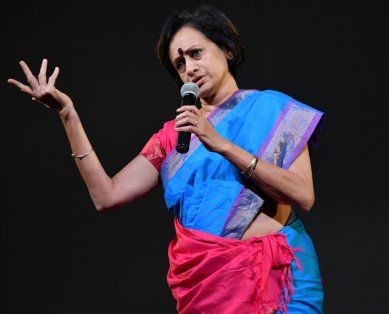 Padmini Ravi 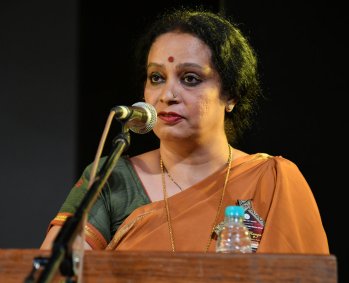 Poornima Gururaja In contrast, Poornima Gururaja in her erudite presentation referred to history of Tanjavur, the bani that developed, the Tanjore Quartet, the systematization of adavus, earlier known as Sadir and various influences, giving examples of Navasandhi, how Brahma sandhi has different raga, how Guru Narmada introduced subtle flourishes. One excellent example she gave was of presence of Madana Kamadeva in varnam Mohamana, in different ragas, how each varnam differentiated the nayika, how Madana was approached in each varnam. She also drew attention to the hastas created by devadasis as they lived in certain atmosphere and looked at nature, even lotus and used it differently in their abhinaya creating variations in the hastas, comparing face with lotus, feet with lotus, the feel of stalk of lotus and subtle variations and usages of hastas created by devadasis. Staying with Nandini Ramani, Saskia Kersenboom in Tanjore began to get insight into the hastas devadasis used. It was a very illuminating demonstration and information. It was also rich in imagination.
Kiran Subramanyam and his wife Sandhya were asked to speak on Kalakshetra bani. Essentially they are disciples of Padmini Ravi, but when as husband and wife they started performing duet, they thought of studying under the Dhananjayans. Their bani, which they later on evolved after separating from Kalakshetra, was also based upon Kalakshetra bani. While preparing the presentation they consulted other senior Kalakshetra exponents like Savithri Jagannath Rao, Deepa Ganesh and learnt from their perspective. When Rukmini Devi started studying under Meenakshisundaram Pillai, Kattumannarkoil Muthukumara Pillai, she systematized the adavus, brought certain order, geometrical precision and her own world view to it to make Bharatanatyam acceptable in her times. She had a vision. Her intension was of art as an uplifting influence. Yes, she did not use certain padams which she did not think were proper, toned down shringara, used nritta technique for dance dramas, therefore sometimes the teermanams were brief and not elaborate. The style of Kalakshetra got established for its geometric lines, angles, etc. The subtleties were introduced by ace mridangam expert and dancer Adyar K Lakshman. But over the years, Kalakshetra bani has also changed. We now see Kalakshetra dancers performing shringara padams and javalis. The most shringara based Gita Govinda kavya was choreographed by Rukmini Devi as a dance drama form. What she was against was excessive shringara which she did not consider full of auchitya. Her emphasis was on spirituality. But even from Kalakshetra, artists like C V Chandrasekhar, Leela Samson and others have shown variations. Both Kiran and Sandhya acknowledged the gratitude for learning under Dhananjayans. They have with sound foundation in one bani built upon sound edifice of their own dance. Mysore Prof .V Subramanya while summing up referred to Gandhiji's statement that 'let windows be open and winds blow in the room but not so violent that I get uprooted.' The openness is a welcome gesture. He insisted that one must have sound training in one bani. And with firm base one can imbibe what is best from other banis. The topic for discussion and demonstration on April 15th was 'Inter-relationship of South Indian classical dance forms-their similarities and influences on each other.' The participants were Minal Prabhu for Bharatanatyam, Dr. Veena Murthy Vijay for Kuchipudi, Melattur S. Natarajan for Bhagavata Mela, Gopika Varma for Mohiniattam and Usha Datar for Kathakali. 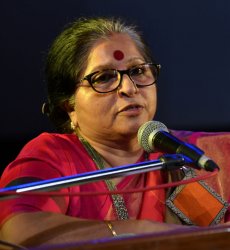 Minal Prabhu 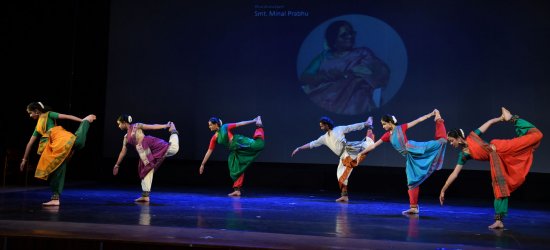 Minal Prabhu's group Minal Prabhu had received training from Kalakshetra for ten years. She explained how she had observed Odissi, Mohiniattam of Kalyanikutty Amma, lilt and grace of Kuchipudi of Vempati Chinna Satyam, the vigour of Kathakali and also Yakshagana. In her choreography which her students demonstrated, she showed how the influences were assimilated without going against the spirit of her basic Kalakshetra Bharatanatyam training - use of charis, movements of Chhau when choreographing in Panchatantra, gaits of animals and birds. In Swaraguccha, how she had used Kuchipudi charis, use of pancha nadai, in Kaliathooki how various sculpturesque poses were used. In Kanjadalayatakshi, when the dance progressed she had also used pirouettes of Yakshagana circling with knees on the floor. From Chennai, Gopika Varma with her student demonstrated how Mohiniattam has developed. In Delhi recently, SNA with Deepti Omcheri Bhalla had arranged a two day seminar where practically all leading dancers had assembled. Several variations, increase in number of Mohiniattam adavus were demonstrated. Saying her own learning of Mohiniattam after studying from Kalyanikutty Amma, Chandrika Kurup and now under Kalamandalam Sugandhi, who also studied Karanas and Natyashastra under Dr. Padma Subrahmanyam, how late Kavalam Narayana Panicker introduced Sopanam music and how that music fits in for exposition of Mohiniattam et al were explained in a lucid manner and with demonstration of salient features of Mohiniattam by her students. Earlier when Tanjore Quartet musicians and dancers were in court of Swati Tirunal, the Mohiniattam form was developed and it had influence of Bharatanatyam, to the point because Carnatic music was used critics used to call it poor cousin of Bharatanatyam. But with Chinnammu Amma, Kalyanikutty Amma and Poet Vallathol's efforts, Mohiniattam developed and now it has acquired its own status as a rich art form. She also spoke about the change in 'side bun', when Kalyanikutty Amma used only one singe plait. Gopika mentioned about earlier repertoire of Cholkettu, Telugu varnam, jatiswarams, tillana which was limited repertoire. Now many more compositions are used. Use of Sopanam music, where there are no gamakas, use of Hastalakshana deepika hastas and restrained abhinaya were mentioned by her. 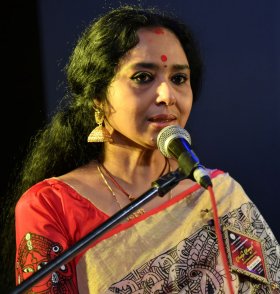 Gopika Varma 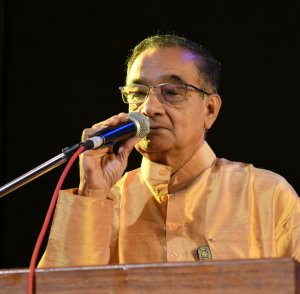 Melattur S. Natarajan Melattur S. Natarajan gave brief introduction of Bhagavata Mela, how in 1943 their institution was established, and every year on Narasimha Jayanti, the artists get together and perform the main play Prahlada Charitram. The plays written by Venkatarama Shastri are still staged and new plays are also written and staged. The music, the patrapravesha darus, Konnangi the buffoon, Ganapati nartanam, entrance of Hiranyakashipu from behind the curtain, similarly of Lilavati, the court Guru, Prahlada and when Hiranyakashipu questions if Lord Vishnu is in a pillar, the pillar bursts open and half man, half lion form of Narasimha with the mask appears, he is in a trance and before he attacks Hiranyakashipu, how stage hands hold him. Then the actor goes from house to house and arati is offered, etc was shown with screening of video recordings which gave audience an idea of how traditional dance dramas are still performed in Melattur. S. Natarajan has now given up his job as an engineer in Dubai and settled in Melattur. His younger brother Kumar, his daughter Aishwarya who is now settled in Bangalore support his endeavours. Natarajan also trains others and they assemble in Melattur village every year for staging of Bhagavata Mela natakams. Kittappa used to teach them Bharatanatyam. Rukmini Devi had invited Balu Bhagavatar and Kalyani amma from Melattur to Kalakshetra to produce Usha Parinayam play. In 1972 and 1974, I had visited Melattur and other villages for documentation, taking photographs of various dance dramas for my Ph.D thesis and had seen majority of dance dramas. Some of the photos of those years are published in my book on Bharatanatyam. Veena Murthy Vijay with her students gave glimpses of traditional training, adugulus, and how various charis are practiced in Kuchipudi. A versatile dancer and disciple of Korada Narasimha Rao, Veena has also studied under C R Acharyulu and Vempati Chinna Satyam. Her most interesting attempt has been incorporating few nritta movements from Yakshagana and artist Surya Rao and Shama demonstrated how Yakshagana movements have been transformed into appropriate Kuchipudi movements in a seamless manner. She has created some 28 adavu patterns. There were comparative movements of Bharatanatyam and similar ones of Kuchipudi and how Kuchipudi movements with their bobbing up and down movements stand out differently was shown by adavus and taking various charis like edakakridita, kartari natu, examples of Kuddittametu adavu, use of agratala sanchara, one unique movement known as Totumanga, after Hanuman's movement of bringing the hillock on which sanjeevini plant was. In druta, fast tempo use of usi typical of Kuchipudi was explained clearly. Also taking cue from Kuchipudi dance drama how she had choreographed Ganga Gauri Vilapam in Kannada. Surya Rao's female impersonation was outstanding. He showed Patrapravesha daru of Satyabhama. His ability to transform with feminine graces is praiseworthy. As a dance drama form Kuchipudi shares some features with Bhagavata Mela natakams. Tarangam is special to Kuchipudi. The dancing with water filled brass vessel and on rim of plate including dancing on the pot are invariable items which at once separates Kuchipudi from other dance forms. On account of time constraints the demonstration of Tarangam was not presented. 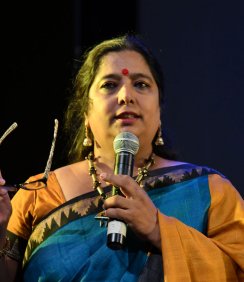 Veena Murthy Vijay 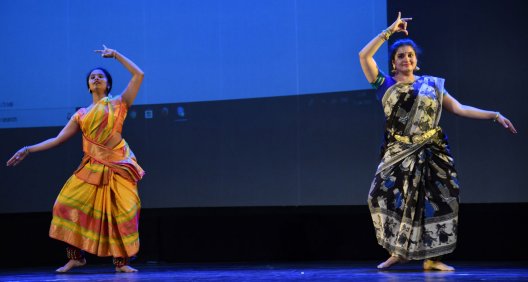 Veena Murthy Vijay's students  Usha Datar 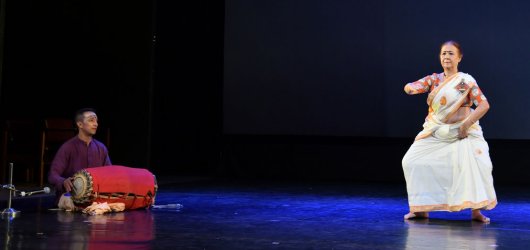 Usha Datar demo Usha Datar was the last speaker. She was asked to speak on Kathakali. The story of her life when she was barely seven or so and being sent away to learn Kathakali was fascinating. She has studied Kuchipudi, Navajanardhana Parijatam, Bharatanatyam, Mohiniattam and Kathakali. Since I cannot follow Kannada, she chose to speak in English and managed very well. Her parents' insistence on sending her to Kerala Kalamandalam, the troubles she had to undergo, the physical punishment the gurus gave if she did not study well and the training were explained with lot of fun and humour. She demonstrated kalasams, hastas, movements of eyebrows, movements of eyes and showed how feet were kept separate. Her son Kartik could join later for accompaniment of maddalam. She was trained for female roles, but she said the only solo performance she could dance was of Puthana Moksham. All other roles would require other characters. She decided to demonstrate meeting of Krishna and Arjuna before the Mahabharata war; she enacted the role of Krishna, Arjuna, the dialogues between them with mukhajabhinaya and hastabhinaya, how the chariot was prepared, how the pillars were fashioned, how the horses were harnessed and patted affectionately, and Arjuna riding the chariot and going to the battlefield. She laced her talk with humour, keeping all of us spellbound with her energy and transparent simplicity, modesty and her abhinaya. In my brief summing up, I mentioned how S. Natarajan was maintaining the tradition of Bhagavata Mela natakams with complete devotion, my experiences at Kerala Kalamandalam and why the tradition still keeps us in thrall, and how the spirit of bhakti pervades as a constant feature in all the dance forms. On the whole, the morning sessions were absolutely engrossing. I felt rewarded attending the three day dance festival along with two day morning sessions of seminar. The word of mouth publicity was enough to bring audiences to Chowdaiah Memorial Hall. It would help organizers if they inform, well in advance, various dance schools who can then send a large number of young dancers to witness senior dancers and their talks and demonstrations. Since Academy of Music has announced to make the dance festival an annual event, one looks forward to attending it in future.  Dr. Sunil Kothari is a dance historian, scholar, author and critic, Padma Shri awardee and fellow, Sangeet Natak Akademi. Dance Critics' Association, New York, has honoured him with Lifetime Achievement award. Post your comments Please provide your name and email id when you use the Anonymous profile in the blog to post a comment. All appropriate comments posted with name & email id in the blog will also be featured in the site. |